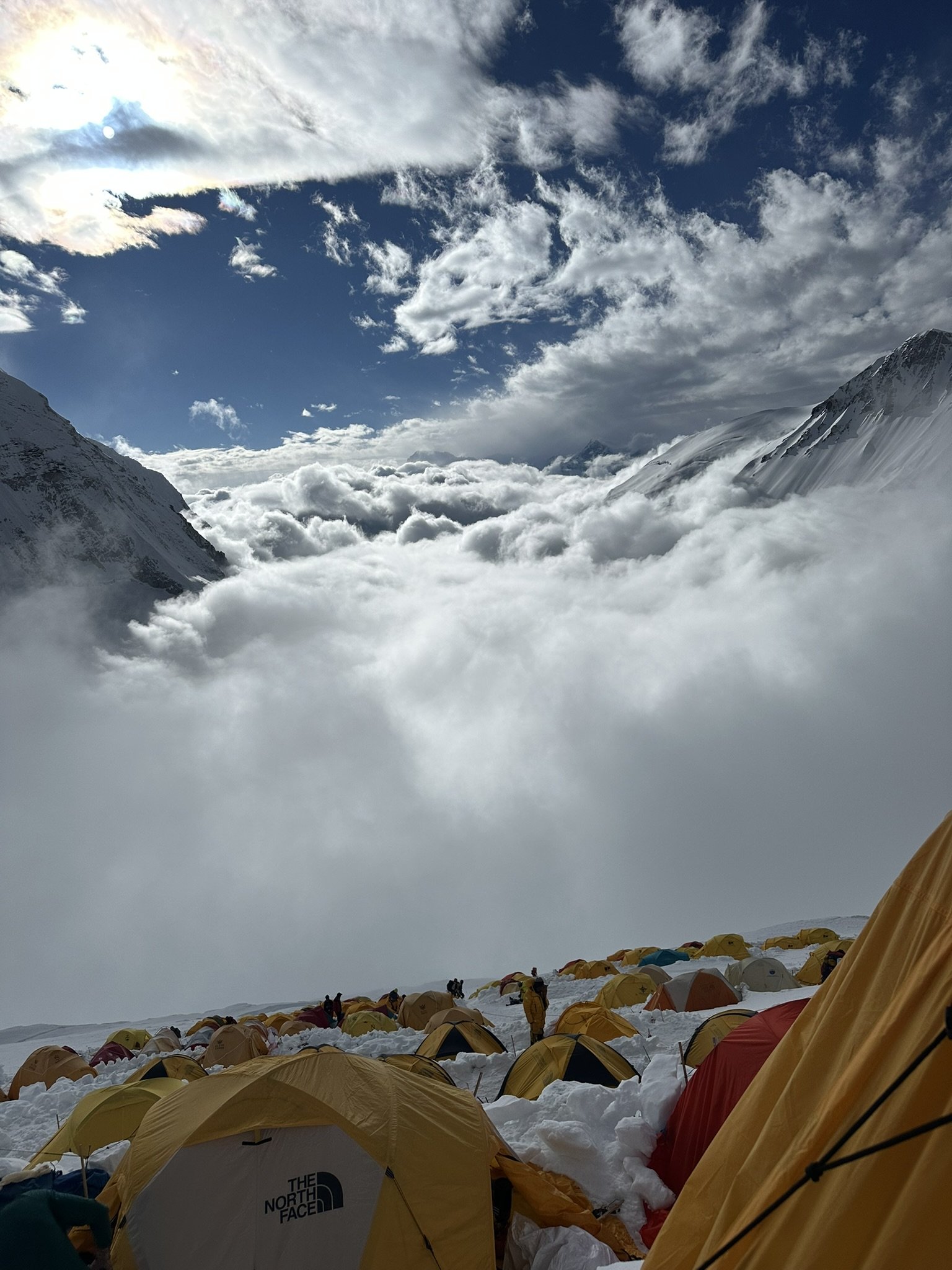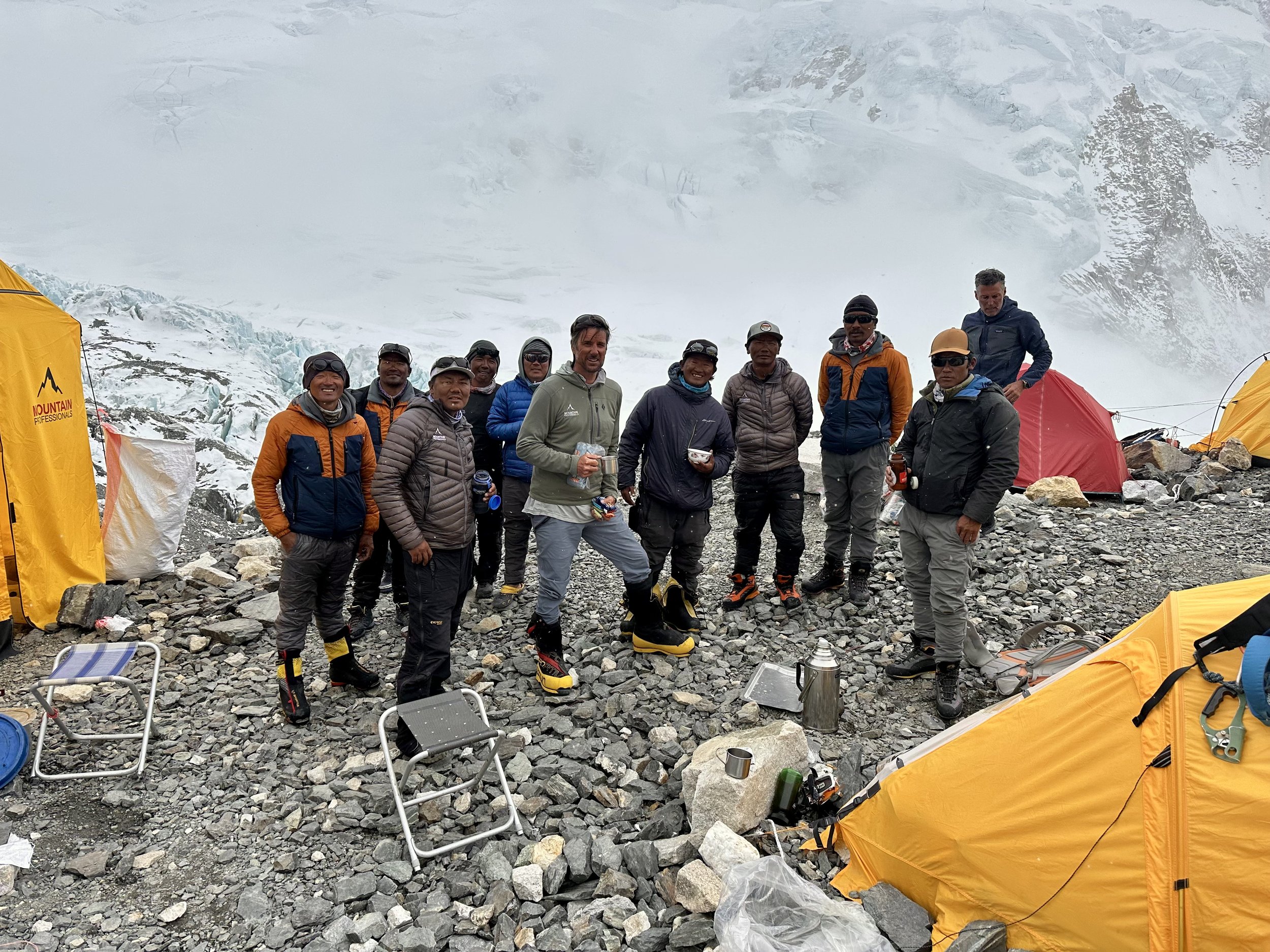I'm writing this much later than I intended. Since returning to Northern Virginia on Memorial Day, I’ve been in full recovery mode—physically and mentally drained from 45 days spent above 17,000 feet, battling bronchitis, mild frostbite, and a close call with high-altitude pulmonary edema (HAPE). Everest took its toll, but I owe everyone a full recounting of what happened on summit day—and the long, unforgiving road back down.
The Climb Begins
At 11:00 PM on May 20, we left Camp 4 (South Col, 26,083 ft) and began our summit bid under a moonless sky. I turned on my Garmin InReach so friends and supporters could track my progress—but the -15°F temperature quickly drained the battery. Moments into the climb, I realized I’d made a serious mistake: the thick socks I’d saved for summit night were damp from a spill earlier. Moisture at this altitude freezes instantly. I returned to my tent to change socks—a slow, difficult task requiring me to remove triple-layer boots and crampons—but it was necessary.
By the time I rejoined the route, the rest of the group had moved ahead. Only Nema, my Sherpa, had stayed back with me.
Climbing Into the Wind
The winds had calmed compared to the violent gusts of the day before. We climbed steadily through 4–6 inches of fresh snow, heading toward the Balcony (27,500 ft). The sky was clear and dark, broken only by the faint glow of distant headlamps. Around 5:00 AM, the sun rose behind us—a brief moment of beauty in an otherwise punishing ascent.
Just below the Balcony, my legs faltered. I wasn’t gaining altitude, and I couldn’t catch my breath. I had run out of oxygen. Dizzy and disoriented, I signaled to Nema, who calmly pulled one of the extra 7-pound tanks from his pack. He had been carrying three bottles—two for me, one for himself.
At the Balcony, we rejoined Ryan, our guide. After a quick break (my water bottles were half-frozen despite deep insulation), we pressed on toward the South Summit.
Whiteout on the Ridge
From the Balcony, we climbed a narrow 18-inch-wide ridge, fully exposed to 10–25 mph crosswinds and complete whiteout conditions. No climbers in sight—no queues, no footsteps—just a windswept void. The solitude was surreal.
At 12:30 PM, we reached the South Summit (28,700 ft). It’s typically the first place climbers glimpse the final summit ridge—usually crawling with people. For us, it was empty. Just me and Nema, alone in the wind.
The Moment of Truth
As we approached the Hillary Step, I paused. I knew I was operating on less than 50% of my physical capacity. It was 1:30 PM, and I was exhausted. Turning back seemed sensible—but I trusted Ryan and Nema completely. I chose to push on.
At the base of the Step lay the body of a fallen climber. To clip into the fixed ropes, I had to step around him and use his backpack for footing. A sobering moment. At the top of the Hillary Step, Ryan appeared, descending with Grace and Jason, who had summited 30 minutes earlier.
Ryan said simply, “Let’s go, Len.”
The Summit
Twenty minutes later—after ten hours of climbing—I stood on the summit of Mount Everest (29,032 ft). No view. Just wind, whiteout, and silence.
We took a photo with the Hopecam flag and another with a picture of Davian, the young man we were honoring that day. Nema and I shared a final photo before beginning our descent.
We spent just ten minutes at the summit. My phone battery was dead, and my fingers were numb—but the memory of that final push—the solitude, the resolve, the trust—will stay with me forever.
The Descent
The descent was a mix of rappelling and arm-wrapping down fixed lines, leaping over obstacles, and navigating steep terrain. Though downhill is faster, it’s far more dangerous. I was grateful for the double safety checks by Ryan and Nema as we descended 3,000 vertical feet.
Near the ridge leading back to the Balcony—about halfway down—I became disoriented and drifted off trail. Suddenly, I plunged chest-deep into a crevasse, less than five feet from the route. I had run out of oxygen again.
Tethered to the safety line, I was left suspended above a 50-foot chasm. Nema motioned for me to roll gently toward the rope, then pulled me to safety. Once back on the ridge, he swapped in a fresh tank, and the trail came back into view. Ryan was waiting 100 feet below.
We descended the final 1,500 feet to Camp 4 in darkness, guided by headlamps and seven more rope lines. The final ice field was slick but led us straight to the tents at South Col.
Return to Camp
We’d been on our feet for 22 hours. Winds were howling again as I slid into the tent vestibule, removed my crampons, and crawled into my sleeping bag. It was 9:00 PM. My tentmate Matt, who had returned to Camp 2 earlier due to snow blindness, had vacated the tent. A single-person tent is far colder than one with two bodies, and it took a while to feel warmth again.
By 11:00 PM, a deep cough had set in—this time with thick green mucus. It was the start of something more serious that would complicate my descent in the days ahead.
But for now, I knew this: I had done it.
I had reached the top of the world.
Stay tuned—I’ll be sharing more about my journey from Camp 4 to home, and the moments of reflection that followed.











